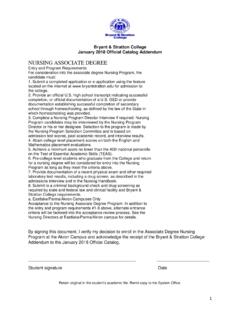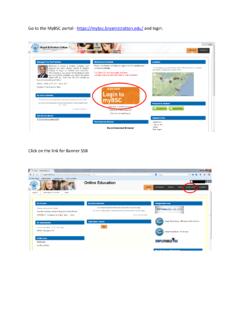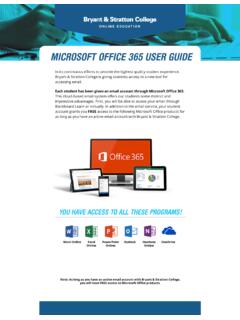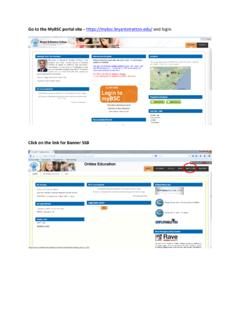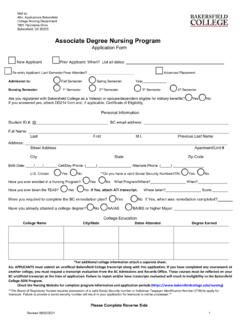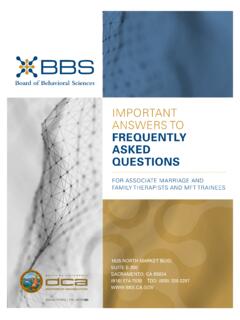Transcription of ADN Program Handbook - Bryant and Stratton College
1 Bryant & Stratton College associate degree Nursing Program Student Handbook Spring 2020 Bryant & Stratton College associate degree Handbook Spring 2020 Created 8-3-14, Revised 1-7-15, Revised 4-30-15, Revised 9-3-15, Revised 9-8-15, Revised 1-6-15, Revised 3-23-16, Revised 4/5/2016, Revised 8/11/2016, revised 11-21-16, revised 12-02-16, revised 4/13/17, revised 8/11/2017, 8/24/17, revised 11/13/17, revised 1/5/18, revised 4/2/18, revised 7/10/18, revised 7/26/18, revised 12/13/18, revised 4/25/19, revised 8/14/19, 1/6/2020 2 Table of Contents Page Nursing Program Approval 3 College Mission Statement 3 College Vision Statement 3 Nursing Program Mission Statement 3 Nursing Program Goals 3 Nursing Program Philosophy 4 Organizing Framework 5 Nursing Program Student Learning Outcomes 5 Nursing Program Governance 6 Nursing Program Information Nursing Program Entry and Program Requirements 7 Health Requirements for the Nursing Program 7 Background Record Check Requirements 8 Ohio Board of Nursing Screening 9 Wisconsin Criminal Background Check 11 Virginia Criminal Background Check 12 Federal Law 14 Uniform Requirements 14 Equipment Requirements 15 Professional Appearance 15 Transportation to Clinical Site 15 Academic Policies and Procedures 16 Transfer Credit and Proficiency Credit 16 Course
2 Grading Scale 17 Academic Advisors 17 ATI-Testing 18 Progression through the Nursing Program Acceptable Achievement in Nursing Courses 18 Repeat of a Nursing Course 18 Grade Appeal 18 Non-Grade Related Grievance Process 18 Program Jeopardy Status 19 Release from the Nursing Program 19 Re-entry into the Nursing Program 19 Attendance Policy 20 Completion of the Nursing Program 23 Medication Calculation Competency 23 Supervision of a Student in Clinical 23 Safe Nursing Practice Definition 24 Unsafe Practice Procedures 24 Professional Student Conduct 24 Substance Abuse 26 Student Conduct 26 Professional Licensure Application Process 27 Statement of Confidentiality 27 Student Health and Counseling Services 27 Student Illness or Injury Policy 27 Accidental Exposure 28 Fees and Expenses 28 Student Acknowledgement of Handbook 29 Bryant & Stratton College associate degree Handbook Spring 2020 Created 8-3-14, Revised 1-7-15, Revised 4-30-15, Revised 9-3-15, Revised 9-8-15, Revised 1-6-15, Revised 3-23-16, Revised 4/5/2016, Revised 8/11/2016, revised 11-21-16, revised 12-02-16, revised 4/13/17, revised 8/11/2017, 8/24/17, revised 11/13/17, revised 1/5/18, revised 4/2/18, revised 7/10/18, revised 7/26/18, revised 12/13/18, revised 4/25/19, revised 8/14/19, 1/6/2020 3 The information in this Handbook is NOT A CONTRACT with students and is subject to change at any time without notice.
3 Students will be notified of new policies or changes to present specific nursing policy and procedures via e-mail by the Nursing Program Director. Questions regarding updates may be directed to the Nursing Program Director. If any information in this Handbook conflicts with the State or Federal Statute, Rules, or Regulations, the State or Federal Statutes, Rules, or Regulations will control. I. About the Nursing Program This Handbook was developed to provide faculty and students in the Nursing Program with information and answers to questions concerning the Nursing Program at Bryant & Stratton College . Included in this Handbook : a. Program -specific information b. Academic policies and procedures relating to the Nursing Program Students who deviate from the requirements and obligations set forth in this Handbook and in the Official Catalog are subject to appropriate action including suspension or dismissal from the College and release from the Nursing Program .
4 Approval The Nursing Program is approved by the Ohio Board of Nursing, the Wisconsin Board of Nursing, and the Virginia Board of Nursing. The Nursing programs in Hampton and Virginia Beach have initial approval by the Virginia Board of Nursing. College Mission Statement Bryant & Stratton College offers a personalized career education and experience leading to high-demand professions so graduates are prepared for their career and life pursuits. College Vision Statement Bryant & Stratton College will offer a personalized and customized career education and experience leading to high-demand professions so graduates adapt to 21st century career and life pursuits. Nursing Program Mission Statement The mission of the associate degree of Nursing Program of Bryant & Stratton College Nursing Program is to prepare safe and effective entry level registered nurses through relevant, high quality and contemporary nursing education.
5 Nursing Program Goals a. Prepare associate of Applied Science in Nursing graduates to function in professional registered nursing roles. b. Provide a foundation of learning which promotes integration of clinical decision making processes into the provision of nursing care for meeting the health/illness needs of patients across the lifespan. Bryant & Stratton College associate degree Handbook Spring 2020 Created 8-3-14, Revised 1-7-15, Revised 4-30-15, Revised 9-3-15, Revised 9-8-15, Revised 1-6-15, Revised 3-23-16, Revised 4/5/2016, Revised 8/11/2016, revised 11-21-16, revised 12-02-16, revised 4/13/17, revised 8/11/2017, 8/24/17, revised 11/13/17, revised 1/5/18, revised 4/2/18, revised 7/10/18, revised 7/26/18, revised 12/13/18, revised 4/25/19, revised 8/14/19, 1/6/2020 4 Nursing Program Philosophy The Bryant & Stratton College nursing Program subscribes to and functions within the mission of BSC to deliver outcomes-based nursing education through a flexible contemporary curriculum in a personalized environment with emphasis on authentic and experiential education.
6 In addition, the curriculum incorporates our values that advocate patient-centered care, teamwork and collaboration, evidence based practice, quality improvement, safety, and informatics. The four concepts of the nursing meta-paradigm that include, person, health, environment, and nursing provide the foundation of the total nursing Program . Person is defined as the individual who may be well or ill, and includes family and community. We believe that the person is a biopsychosocial, cultural, and spiritual being who grows, develops, and adapts throughout the lifespan. We also believe that all people, as members of the global society are endowed with intellectual capabilities which direct them toward uniqueness, autonomy, and self-fulfillment. The faculty recognize the importance of respecting the dignity of the person as well as providing an atmosphere that is supportive, caring, and responsive.
7 Health is a dynamic human experience that is a combination of wellness-illness and is defined by the perception of the person across the lifespan. Each person perceives health in a unique manner according to developmental stage, cultural context, spirituality, preferences, and health literacy. The faculty endeavor to provide students with the opportunity to assume new nursing roles in health education, wellness, prevention, and provision of care to patients who have healthcare needs. Environment is a system that provides the framework for interactions to address a person s needs and goals. It is inclusive of physical surroundings as well as local, regional, national, global, social, political, emotional, psychological, and economic conditions that are associated with a person s health. Environment also includes intellectual, cultural, and spiritual aspects affecting the whole person.
8 The faculty affirm that the unique responses by the individual or family to constant interaction with the environment results in varying degrees of health. Consistent with faculty beliefs, nursing is an essential healthcare professional discipline that focuses on the art and science of holistic healthcare guided by the values of caring, diversity, excellence, integrity, ethics, holism, and patient-centeredness. Nurses use clinical judgment, and information literacy skills to provide safe quality care based on best current evidence to promote the health of patients, families, and communities to achieve an optimal level of patient wellness in diverse settings. Nursing includes the roles of provider of care, manager of care, teacher, researcher, and advocate. As a provider of care the nurse utilizes the nursing process, clinical judgment, communication, leadership skills, and clinical competence in order to maintain or restore patients to their optimum state of health or wellness or support death with dignity.
9 In order to assume the role of manager of care, the nurse utilizes collaboration, organization, delegation, accountability, advocacy, and respect to provide and coordinate care for groups of patients who have healthcare needs. As a member of the discipline of nursing the nurse demonstrates a commitment to professional growth, lifelong learning, and is responsible for upholding high standards of practice within the ethical and legal framework of nursing. Bryant & Stratton College associate degree Handbook Spring 2020 Created 8-3-14, Revised 1-7-15, Revised 4-30-15, Revised 9-3-15, Revised 9-8-15, Revised 1-6-15, Revised 3-23-16, Revised 4/5/2016, Revised 8/11/2016, revised 11-21-16, revised 12-02-16, revised 4/13/17, revised 8/11/2017, 8/24/17, revised 11/13/17, revised 1/5/18, revised 4/2/18, revised 7/10/18, revised 7/26/18, revised 12/13/18, revised 4/25/19, revised 8/14/19, 1/6/2020 5 Organizing Framework The six roles of the associate degree nurse (Advocate, Member of Discipline, Provider of Care, Researcher, Manager of Care, and Teacher) describe nursing practice and role expectations of the entry level registered nurse.
10 The core components of those roles, as established by QSEN are as follows: Quality Improvement, Safety, Informatics, Evidence Based Practice, Patient Centered Care, and Teamwork & Collaboration. These components, along with the nursing metaparadigm, are reflected in the Bryant & Stratton College Nursing Program organizing framework. The organizing framework provides direction for the selection and ordering of learning experiences to achieve student learning outcomes. Nursing Program Student Learning Outcomes Graduates from the associate degree Nursing Program will be able to: 1. Employ critical thinking and reasoning to utilize the nursing process as a framework to deliver comprehensive, safe, and culturally sensitive care across the lifespan. 2. Demonstrate clinical competence in the performance of nursing skills utilizing quality measures to provide safe effective nursing care.
